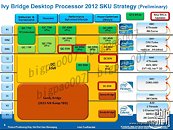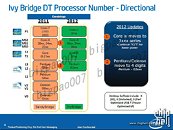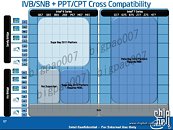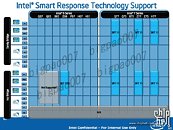Tuesday, October 18th 2011

Ivy Bridge Quad-Core to Have 77W TDP, Intel Plans for LGA1155 Ivy Bridge Entry
Intel's next generation "Ivy Bridge" Core processors slated for 2012 will mark the beginning of Intel's transition to the brand new 22 nanometer fab process. It looks like Ivy Bridge will significantly benefit from this transition, since Intel will raise the bar in terms of energy-efficiency. Even the fastest P1 (performance 1) tier quad-core chips will have TDP rated as low as 77W, down from the 95W Core i7 2600K, for example, has.
The punters at Intel marketing have sliced the market down to finer segments, to better address it. The market is sliced in terms of price-segments (vertical), and in terms of target users (horizontal). The two markers are independent of each other, yet they complement each other in pin-pointing areas of the market Intel can address. Ivy Bridge LGA1155 is restricted to P1 (performance tier 1) segment on the top, with higher tiers, along with HEDT (high-end desktop) being reserved for Sandy Bridge-E LGA2011, and future "Ivy Bridge-E". Horizontally, Intel will have "K" quad-core parts for Enthusiast, standard (locked) quad-core vPro for the Standard, "T" quad-core for Performance-optimized lifestyle, and "S" for Power-optimized lifestyle. Chaotic as it looks, the table below lays out the lineup perfectly.Unlocked "K" and standard (locked) vPro quad-core parts have TDP of 77W, performance-optimized "T" quad-core parts at 65W, and power-optimized "S" quad-core parts at 45W. There are dual-core Core i3 parts, too, with TDP of 55W (35W for the "S" variants).
The P1 segment parts will fall within the Core i7-3700 series, these chips will have the full 8 MB L3 cache present on the Ivy Bridge silicon, and 4 cores with 8 threads (HyperThreading enabled). Just below P1 segment are the MS2 and MS1 segments, the MS2 segment will include quad-core parts with 6 MB L3 cache, and no HyperThreading. The top-most MS2 part will have an unlocked multiplier, much like today's Core i5-2500K. MS2 and MS1 segment parts will take up Core i5-3500 series, Core i5-3400 series, and Core i5-3300 series. There will be just one class of dual-core parts, in the power-optimized MS1 segment. These segments will get have an updated feature-set over the present generation, that includes AES-NI acceleration, PP-DRNG.Dual-core parts will span across key low-end and value segments. The 55W dual-core silicon will form the bed for SKUs in all four horizontal segments, in T2, T1, and L3 vertical segments. T2 and T1 segment parts will carry the Core i3-3100 series SKUs. These chips will have HyperThreading technology enabled, along with AVX, and updated GPU feature-set. The L3 segment will house the cheapest Ivy Bridge processor, in the Pentium Dual-Core G2000 family. This chip will now support dual-channel DDR3-1600 MHz.
Moving on to backwards compatibility with current Intel 6-series chipset motherboards, let me kill the suspense here. Ivy Bridge will run on Intel 6-series chipset motherboards, provided:
Sources:
ChipHell, VR-Zone
The punters at Intel marketing have sliced the market down to finer segments, to better address it. The market is sliced in terms of price-segments (vertical), and in terms of target users (horizontal). The two markers are independent of each other, yet they complement each other in pin-pointing areas of the market Intel can address. Ivy Bridge LGA1155 is restricted to P1 (performance tier 1) segment on the top, with higher tiers, along with HEDT (high-end desktop) being reserved for Sandy Bridge-E LGA2011, and future "Ivy Bridge-E". Horizontally, Intel will have "K" quad-core parts for Enthusiast, standard (locked) quad-core vPro for the Standard, "T" quad-core for Performance-optimized lifestyle, and "S" for Power-optimized lifestyle. Chaotic as it looks, the table below lays out the lineup perfectly.Unlocked "K" and standard (locked) vPro quad-core parts have TDP of 77W, performance-optimized "T" quad-core parts at 65W, and power-optimized "S" quad-core parts at 45W. There are dual-core Core i3 parts, too, with TDP of 55W (35W for the "S" variants).
The P1 segment parts will fall within the Core i7-3700 series, these chips will have the full 8 MB L3 cache present on the Ivy Bridge silicon, and 4 cores with 8 threads (HyperThreading enabled). Just below P1 segment are the MS2 and MS1 segments, the MS2 segment will include quad-core parts with 6 MB L3 cache, and no HyperThreading. The top-most MS2 part will have an unlocked multiplier, much like today's Core i5-2500K. MS2 and MS1 segment parts will take up Core i5-3500 series, Core i5-3400 series, and Core i5-3300 series. There will be just one class of dual-core parts, in the power-optimized MS1 segment. These segments will get have an updated feature-set over the present generation, that includes AES-NI acceleration, PP-DRNG.Dual-core parts will span across key low-end and value segments. The 55W dual-core silicon will form the bed for SKUs in all four horizontal segments, in T2, T1, and L3 vertical segments. T2 and T1 segment parts will carry the Core i3-3100 series SKUs. These chips will have HyperThreading technology enabled, along with AVX, and updated GPU feature-set. The L3 segment will house the cheapest Ivy Bridge processor, in the Pentium Dual-Core G2000 family. This chip will now support dual-channel DDR3-1600 MHz.
Moving on to backwards compatibility with current Intel 6-series chipset motherboards, let me kill the suspense here. Ivy Bridge will run on Intel 6-series chipset motherboards, provided:
- They use the following chipsets: Z68, P67, H67, or H61 (Q67 and Q65 are not supported);
- The motherboards feature ME8L UEFI update. For this:
o Your motherboard should currently feature a UEFI firmware
o It should support ME8L update process at the physical level, where the EEPROM is sufficiently large




74 Comments on Ivy Bridge Quad-Core to Have 77W TDP, Intel Plans for LGA1155 Ivy Bridge Entry
Is the new Intel products coplete rubish, but those would shine any way vs the "mighty" Buldozzer?
Or there will be monopoly like pricing?
* I know many people that only do office work, that still use single cores like P4, Athlon XP and heck I still have a 486 that works (if only was useful). Obviously those are not usable by todays standards, or not desirable (P4/Athlon XP), but a quad core CPU will always be enough for "home use" unless tasks like web surfing and office are deliberately made a lot harder to run, wich would stink even to illitertes IMO. So people would hold on to those for as long as the hardware lived or until there's a new CPU that brings a massive performance advantage for very little price. Intel can't just afford to sell you 1 CPU every 10 years, they need you tu buy their CPUs every 3-4 years minimum.
" The motherboards feature ME8L UEFI update. For this:
o Your motherboard support currently feature a UEFI firmware
o It should support ME8L update process at the physical level, where the EEPROM is sufficiently large" ?
Will be buying the MSI Z68A-65GD G3
Still rockin it!! :rockout: I may upgrade eventually, but haven't had a real need to quite yet.
Intel's threat is ARM, and they need to move fast on die shrinks and aggressive power saving to meet this threat. It's coming.
Intel and ARM vendors target entirely different markets. It's like comparing a sportscar company to a sportsbike company.
And, the trend is continuing at increased pace. Not only do we have more capable smartphones, but those same chips are running tablets, which traditionally were x86 territory.
You really think the spheres are separate? And will continue to remain totally separate?
They most definitely are not.
That's not to say that ARM and x86 will never cross paths. Intel is struggling to miniaturize x86 to maintain performance per watt levels comparable to ARM, while ARM designers like NVIDIA dream of one day kicking out x86 processor from the PC.
I recently got an ASRock z68 extreme4 gen3, but i bet despite it supporting Pci-e 3 theres still some reason we'll all need a new mobo when Ivy Bridge releases.